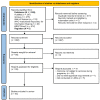Health Systems Determinants of Delivery and Uptake of Maternal Vaccines in Low- and Middle-Income Countries: A Qualitative Systematic Review
- PMID: 37112781
- PMCID: PMC10144938
- DOI: 10.3390/vaccines11040869
Health Systems Determinants of Delivery and Uptake of Maternal Vaccines in Low- and Middle-Income Countries: A Qualitative Systematic Review
Abstract
Maternal vaccination is considered a key component of the antenatal care package for improving maternal and child health. Low- and middle-income countries (LMICs) fall short of global targets to prevent maternal and neonatal deaths, with a disproportionate burden of vaccine-preventable diseases. Strategies towards ending preventable maternal mortality necessitate a health systems approach to adequately respond to this burden. This review explores the health systems determinants of delivery and uptake of essential maternal vaccines in LMICs. We conducted a qualitative systematic review of articles on maternal vaccination in LMICs, published between 2009 and 2023 in line with the Preferred Reporting Items for Systematic Reviews and Meta-Analysis guidelines. Thematic analysis was conducted to identify key themes in the literature, interpreted within a conceptual framing that explores the systems determinants influencing maternal vaccines. Our search yielded 1309 records, of which 54 were included, covering 34 LMICs. Most of the included studies were from South America (28/54) and included pregnant women as the primary study population (34/54). The studies explored influenza (25/54) and tetanus toxoid (20/54) vaccines predominantly. The findings suggest that systems hardware (lack of clear policy guidelines, ineffective cold-chain management, limited reporting and monitoring systems) are barriers to vaccine delivery. Systems software (healthcare provider recommendations, increased trust, higher levels of maternal education) are enablers to maternal vaccine uptake. Findings show that formulation, dissemination and communication of context-specific policies and guidelines on maternal vaccines should be a priority for decision-makers in LMICs.
Keywords: health system; low- and middle-income countries; maternal health; pregnancy; vaccine.
Conflict of interest statement
The authors declare no conflict of interest.
Figures



Similar articles
-
Beyond the black stump: rapid reviews of health research issues affecting regional, rural and remote Australia.Med J Aust. 2020 Dec;213 Suppl 11:S3-S32.e1. doi: 10.5694/mja2.50881. Med J Aust. 2020. PMID: 33314144
-
Factors influencing the prioritization of vaccines by policymakers in low- and middle-income countries: a scoping review.Health Policy Plan. 2023 Mar 16;38(3):363-376. doi: 10.1093/heapol/czac092. Health Policy Plan. 2023. PMID: 36315461
-
Antenatal care service delivery and factors affecting effective tetanus vaccine coverage in low- and middle-income countries: Results of the Maternal Immunisation and Antenatal Care Situational analysis (MIACSA) project.Vaccine. 2020 Jul 14;38(33):5278-5285. doi: 10.1016/j.vaccine.2020.05.025. Epub 2020 Jun 8. Vaccine. 2020. PMID: 32527598 Free PMC article.
-
Determinants of maternal immunization in developing countries.Vaccine. 2015 Jun 12;33(26):2971-7. doi: 10.1016/j.vaccine.2015.04.070. Epub 2015 Apr 30. Vaccine. 2015. PMID: 25936666
-
Maternal immunization: trends in South and Southeast Asian countries.J Matern Fetal Neonatal Med. 2022 Dec;35(25):8372-8381. doi: 10.1080/14767058.2021.1974389. Epub 2021 Sep 13. J Matern Fetal Neonatal Med. 2022. PMID: 34517746 Review.
Cited by
-
Vaccination Guidelines for Pregnant Women: Addressing COVID-19 and the Omicron Variant.Med Sci Monit. 2024 Jan 17;30:e942799. doi: 10.12659/MSM.942799. Med Sci Monit. 2024. PMID: 38229424 Free PMC article.
-
Recommendations for Integrating Traditional Birth Attendants to Improve Maternal Health Outcomes in Low- and Middle-Income Countries.Int J MCH AIDS. 2024 Sep 13;13:e019. doi: 10.25259/IJMA_16_2024. eCollection 2024. Int J MCH AIDS. 2024. PMID: 39526165 Free PMC article.
-
Facilitators and barriers to maternal immunization and strategies to improve uptake in low-income and lower-middle income countries: A systematic review.Hum Vaccin Immunother. 2024 Dec 31;20(1):2411823. doi: 10.1080/21645515.2024.2411823. Epub 2024 Oct 29. Hum Vaccin Immunother. 2024. PMID: 39473171 Free PMC article.
-
Interventions to Improve Knowledge, Attitudes, and Uptake of Recommended Vaccines during Pregnancy and Postpartum: A Scoping Review.Vaccines (Basel). 2023 Nov 21;11(12):1733. doi: 10.3390/vaccines11121733. Vaccines (Basel). 2023. PMID: 38140138 Free PMC article.
-
Comparison of Wealth-Related Inequality in Tetanus Vaccination Coverage before and during Pregnancy: A Cross-Sectional Analysis of 72 Low- and Middle-Income Countries.Vaccines (Basel). 2024 Apr 17;12(4):431. doi: 10.3390/vaccines12040431. Vaccines (Basel). 2024. PMID: 38675813 Free PMC article.
References
-
- Alkema L., Chou D., Hogan D., Zhang S., Moller A.-B., Gemmill A., Fat D.M., Boerma T., Temmerman M., Mathers C., et al. Global, regional, and national levels and trends in maternal mortality between 1990 and 2015, with scenario-based projections to 2030: A systematic analysis by the UN Maternal Mortality Estimation Inter-Agency Group. Lancet. 2016;387:462–474. doi: 10.1016/S0140-6736(15)00838-7. - DOI - PMC - PubMed
Publication types
LinkOut - more resources
Full Text Sources

